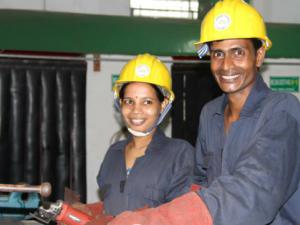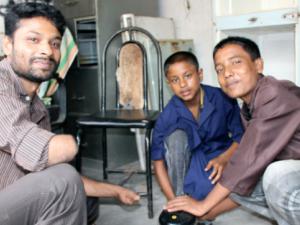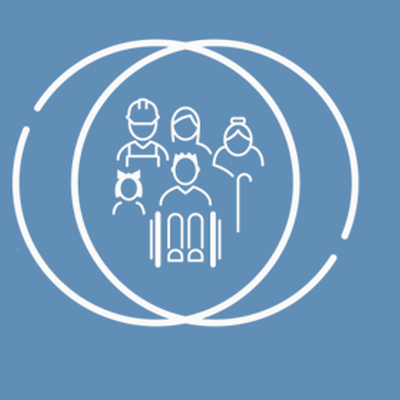In 2006 the Government of Bangladesh initiated a major overhaul of Technical Vocational Education and Training (TVET) in Bangladesh, with support from the European Union. The project, implemented by the International Labour Office (ILO), has achieved a couple of ‘first’s’ in the country’s history: it has produced a National Skill Development Policy, a National Qualifications Framework, and it promotes social inclusion.
Bangladesh is a small, low-income country with a large population of 160 million people. This provides a huge potential for further economic development, but progress is hindered by three main factors: poor infrastructure, poor energy distribution and the lack of skilled workers.

Lacks of skills reflect in the country’s high rate of unemployment, and it also causes underemployment - Bangladesh has more than six million migrant workers, but most of them are low skilled, making money in low paid jobs.
“We have companies coming in like Adidas, who want to employ tens of thousands of workers but they can’t get skilled workers,” explained Arthur Earl Shears, ILO’s Chief Technical Advisor on the TVET Reform Project in Bangladesh. “We have growth industries like ship building, ceramics, pharmaceuticals, leather – but production needs workers, managers, supervisors and technicians, and this is the kind of niche we are trying to fill with the TVET Reform Project.”
TVET is not new to Bangladesh - there have been training institutions in Bangladesh since before Independence in 1971 - but traditionally these haven’t had strong links with industry. In addition, the quality of these older programmes was not trusted.
From 2007 -2013, as part of the 10th EDF, the EU injected 14 million euros into working with the government and partners to set a policy framework that focuses TVET projects to provide skills for Bangladesh.
The project works in the context of the Global Sustainability Compact for Bangladesh, a joint initiative by the Government of Bangladesh, the European Union and the ILO to improve labour rights, working condition and factory safety in the ready-made garment industry.
“The TVET Reform Project links demand and supply with a foundation, which was the National Skills Development Policy,” said Shears. Developed in consultation with the Government, private sector, worker’s groups and NGOs, this policy was approved by the Bangladesh Cabinet in 2012.
Included in this policy is the National Qualification Framework, based on the model operating in the UK, Ireland, Australia and other countries, where the new programmes are based on industry demand, and with quality assurance mechanisms. An institution wishing to run the new certificate programme must undergo a check by a government team, who provides it with feedback and a timescale to get its operation in line with the TVET Quality Assurance standards.
Training is based on acquiring specific competencies for practical application – for instance in welding, air-conditioning maintenance or medical technology, and the qualification is based on these competencies.
“Teachers don’t do final assessments of the students anymore … we invite people from industry who know what this person should be able to do after the training, to watch the students and assess whether or not they can do the job,” said Shears, adding that industry is not used to this level of involvement, and the assessors themselves require training.
The project also works with industry players to improve and formalise training that takes place on the job.
While developing a skills policy was core, Shears and his team also saw the need for other work at the policy level. “TVET institutions are seen locally as kind of ‘guy places’, so in consultation with NGOs, we developed a gender strategy for promoting inclusion of women in TVET.”

The new strategy encourages women to be involved with non-traditional trades. “One example, we have introduced a programme in motorcycle servicing where one third of the trainees are women,“ said Shears.
Recent TVET graduates include a husband and wife team who studied welding on their path as migrant workers. “They can earn twice as much money, and stay together,” said Shears. “ This is novel and exciting for Bangladesh.”

Importantly, the TVET Reform Programme includes a strategy for people with disabilities, where training institutions have been inspected and given recommendations on what to change physically in the environment to make them more accessible for men and women with disabilities.
“It is a night and day picture for the women with disabilities – before, they were often considered by their families as an embarrassment; they couldn’t get married and were hidden away. After this training programme they have self-confidence, a job, they are making money and sending some to the family, they are getting married. It is wonderful to see,” said Shears.
In a country where it is estimated that the garment sector alone needs 200,000 new workers a year, the implementation of the National Skills Development Policy is moving onwards from the adoption/adaption phase into an ‘up-scaling phase’.
“The project has laid the foundation, set and tested the blue print, and now we need more partners to come in – NGOs, Government, private sector, worker’s groups - to upscale and replicate what we have been doing,” said Shears.
The project was presented and discussed in the lab session, Skills for Bangladesh, at the European DevDays 2013. You can listen to the full podcast here.
For more information on technical and vocational education and training (TVET) please visit the capacity4dev.eu public group on Employment and Social Protection.
This collaborative piece was drafted with input from Arthur Shears and Donatella Gobbi, with support from the capacity4dev.eu Coordination Team
Photographs: ILO





Log in with your EU Login account to post or comment on the platform.